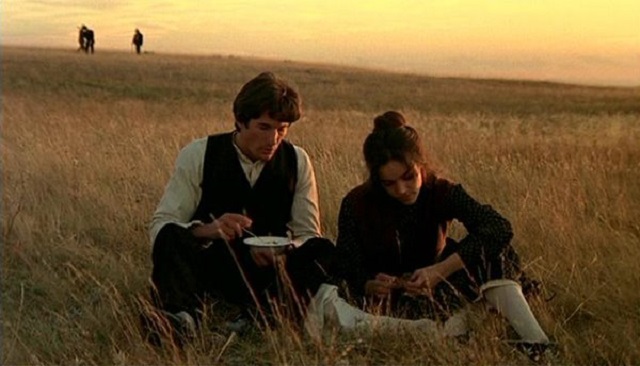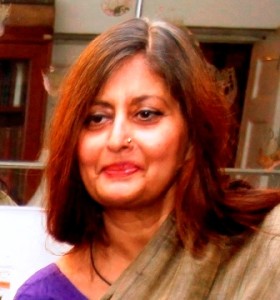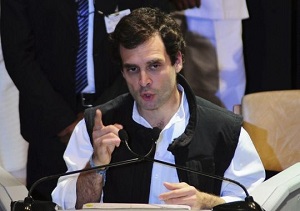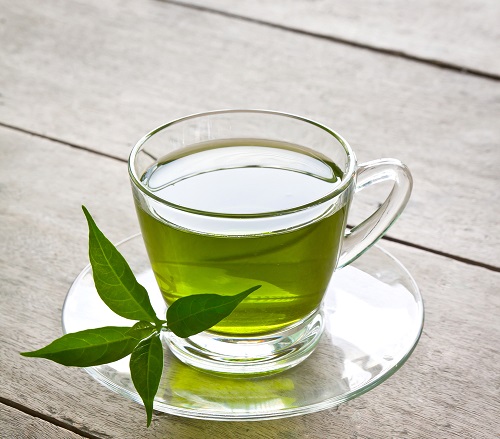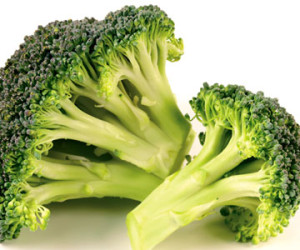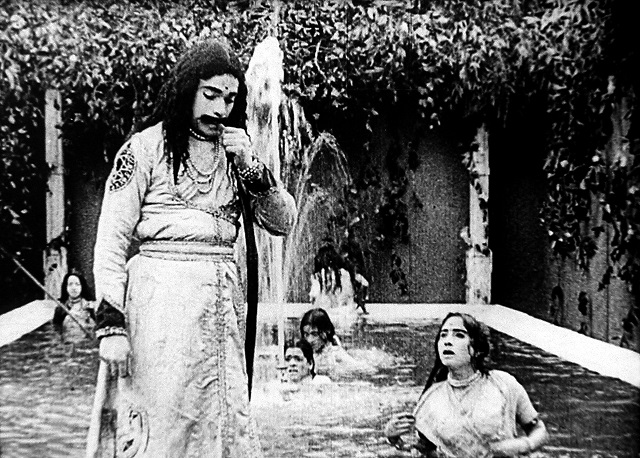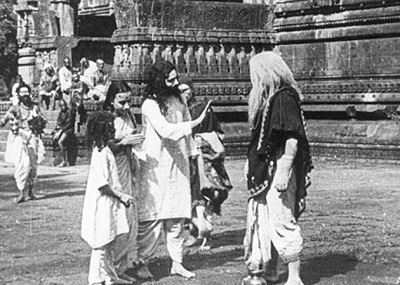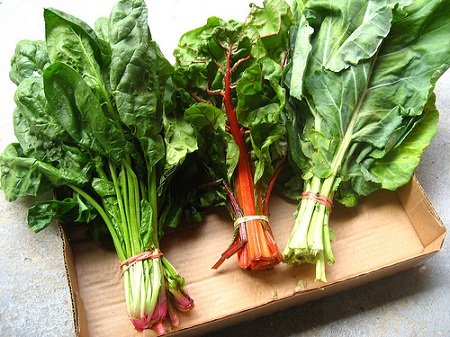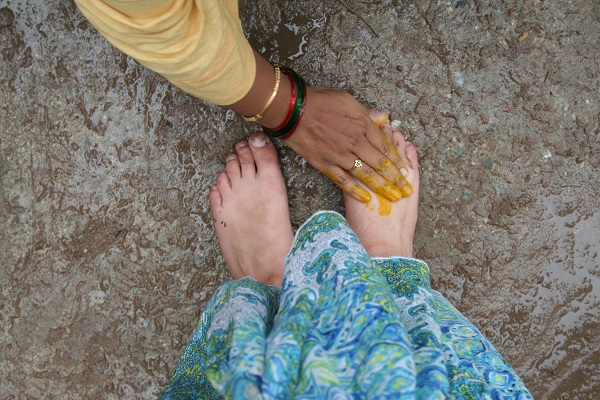We respect our elders by touching their feet – but time constraints have modified this feet-touching act down the ages.
 by Shweyta Mudgal
by Shweyta Mudgal
All of us desis have done this. Stooped low – sometimes hesitantly, sometimes willingly, stretched our hands out and touched the pair of feet standing before us. The ‘touchy feet(y)’ syndrome, as I like to call it, has existed in India since time immemorial.
In spite of its Hindu origins, this custom has traversed multiple faiths. To find a young Indian of any religion touching the feet of an older one to signify reverence and seek blessings is commonplace.
Believers in this act have acclaimed it for its many virtues, humility and respect being the foremost among them. Apparently, on touching someone’s feet, one creates a powerful energy circuit of sorts, supplementing an easy flow of positive energy derived from the ‘touchee’ who completes the ‘circuit’ by placing his hands on the head of the blessing seeker, i.e the ‘toucher’.
For many Indians, touching feet is as second nature as drinking chai, perhaps! Indian streets, shops, malls, wedding halls, restaurants, 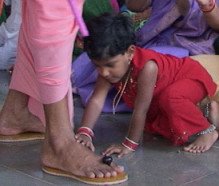 theaters, cinema halls (on and off celluloid), TV screens and homes are replete with the back-bending-foot-touching exercise. Most children, especially those living in joint families, are taught to touch their elders’ feet. In many households even today, the ideal son or daughter-in-law may perhaps leave home without their daily essentials such as wallets or lunch boxes, but dare they leave without some ‘touchy-feet(y)’?
theaters, cinema halls (on and off celluloid), TV screens and homes are replete with the back-bending-foot-touching exercise. Most children, especially those living in joint families, are taught to touch their elders’ feet. In many households even today, the ideal son or daughter-in-law may perhaps leave home without their daily essentials such as wallets or lunch boxes, but dare they leave without some ‘touchy-feet(y)’?
Like most other aspects of our modern-day lives, the gradual, metamorphic adaptation of this age-old tradition too, has been inevitable, as seen below:
Original version: Both feet of the elderly person (the ‘touchee’) were touched with both hands and massaged gently for about half a minute by the ‘toucher’, as the former would shower blessings upon the latter.
Version 1.0: A few years later, the ‘toucher’ would bend down to touch both the feet of the ‘touchee’ sans the massage, thereby saving some time.
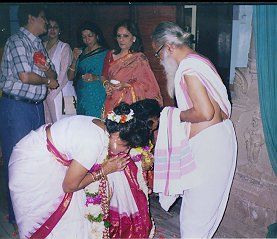 Version 1.1: Time constraints and faster lifestyles further altered the modus operandi. Now, in a matter of a few seconds, the feet toucher would bend, touch one foot with just one hand and straighten up.
Version 1.1: Time constraints and faster lifestyles further altered the modus operandi. Now, in a matter of a few seconds, the feet toucher would bend, touch one foot with just one hand and straighten up.
Version 1.2: Further compaction occurred when the ‘toucher’ would just half-bend to lightly graze the ‘touchee’s’ shin or knee; all in a jiffy.
Version 2 a.k.a The ‘Bluetooth’ Version: This is further ‘instantification’ of the act, without any physical contact between either parties. Now the ‘toucher’ merely fakes a knee bend with one hand pointing towards the ‘touchee’s’ feet. The ‘touchee’ delivers the blessing by a casual positioning of the hand held over the ‘toucher’s’ head.
A ‘flying-kiss’ equivalent of the ‘touching-feet’ exercise; in this last version the act is carried out without actually being carried out at all. It justifies itself and maintains its sole intention, yet adapts a stylistic approach, thus becoming a hilarious irony on the Indian social etiquette scene today!
I was brought up to do the exact opposite of this otherwise sacrosanct act – NOT to touch anyone’s feet! This refrainment was on account of the general North Indian belief that little girls are avatars of Hindu goddesses, thus causing their apotheosis to divinity. A giggly goddess in my growing years, I was notorious in the family for seeking cheeky thrills at seeing all the elders, including my grandparents, trying to touch my feet as I happily swung my legs around, dodging their hands and rendering their attempts futile.
Even as a child, I did not understand this strange podiatric obsession! Or why my family was reversing its pecking order when it came to this one foot-touching practice?
I don’t know about other ‘touchee’s’, but I for one, certainly didn’t like others reaching for my feet. For starters, my feet were really ticklish. Besides my toenails (or the lack thereof) 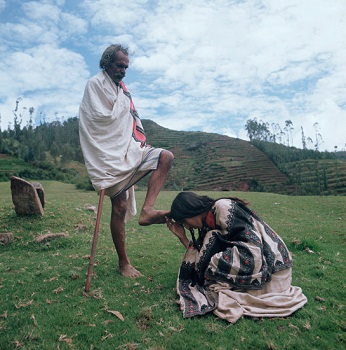 may not always have been the best sight. Furthermore, I’d jump (quite literally) when someone suddenly ducked in front of me, a la mavaali style, in those days!
may not always have been the best sight. Furthermore, I’d jump (quite literally) when someone suddenly ducked in front of me, a la mavaali style, in those days!
I also didn’t like being the ‘toucher’. The only ‘feet-touching’ I really knew back then, was the one executed under the table, playing ‘footsie’ with a love interest. Or the kind of ‘feet-touching-the-ground’ over the head, that I’d indulge in during yoga class, if at all.
Even today – I don’t know, I am just not your traditional feet-toucher. I am more of a hugger, I think! Besides I figured I’d rather pull people’s legs instead of touch their feet. It makes them laugh more, saves me the exercise and most importantly, thrills to bits the giggly goddess inside me! After all, it is her blessing that really counts, doesn’t it?
A Mumbaikar by birth and a New Yorker by choice, recently-turned global nomad Shweyta Mudgal is currently based out of Singapore. An airport designer by day, she moonlights as a writer. ‘Outside In’ is a weekly series of expat diaries, reflecting her perspective of life and travel, from the outside-in. She blogs at www.shweyta.blogspot.com and has her feet on the ground all the time. Perhaps, that’s what makes them so dirty, she believes!
(Pictures courtesy ucscabroad.com, hemanth.net, gorigirl.blogspot.com, www.arcticphoto.co.uk)
 Hailed as one of the world’s greatest living filmmakers, Terrence Malick stands apart from others in being a filmmaker-philosopher whose films are simultaneously beautifully impressionistic and hauntingly profound. Malick is a Rhodes Scholar and a teacher at the prestigious MIT and his films are a spellbinding visual experience and traverse the field of questions about existence, god and nature. With a visual and narrative style that is consistent throughout his entire body of work, he works with an enigmatic approach to narrative and character, innovative voice overs and a subtle juxtaposition of natural beauty with violence and an almost poetic investigation into dreams and nightmares.
Hailed as one of the world’s greatest living filmmakers, Terrence Malick stands apart from others in being a filmmaker-philosopher whose films are simultaneously beautifully impressionistic and hauntingly profound. Malick is a Rhodes Scholar and a teacher at the prestigious MIT and his films are a spellbinding visual experience and traverse the field of questions about existence, god and nature. With a visual and narrative style that is consistent throughout his entire body of work, he works with an enigmatic approach to narrative and character, innovative voice overs and a subtle juxtaposition of natural beauty with violence and an almost poetic investigation into dreams and nightmares.